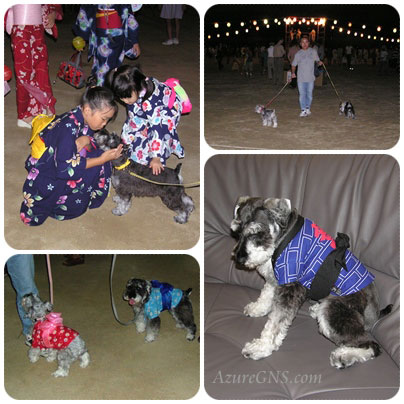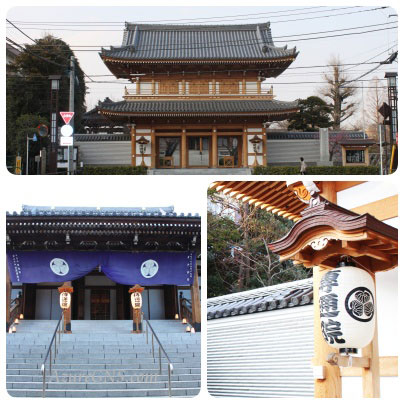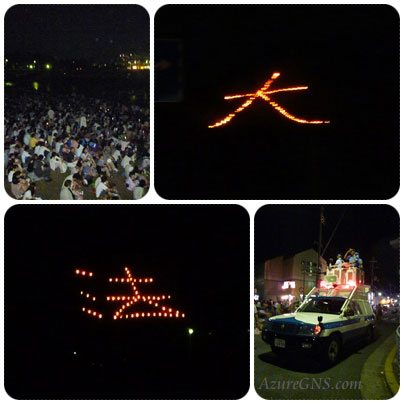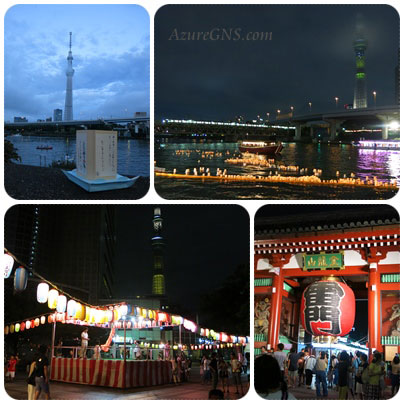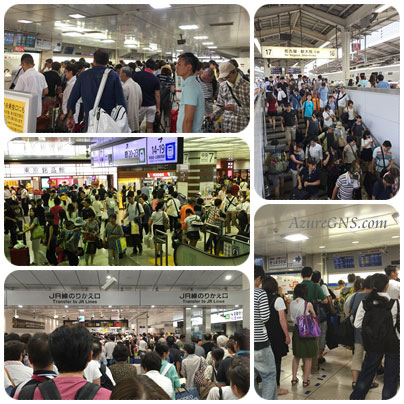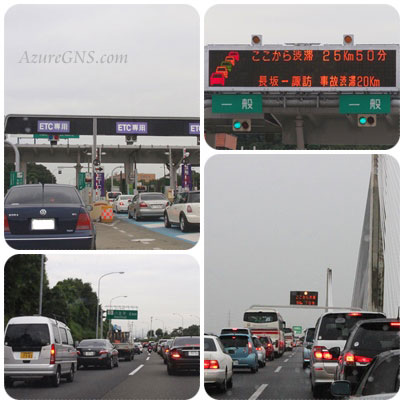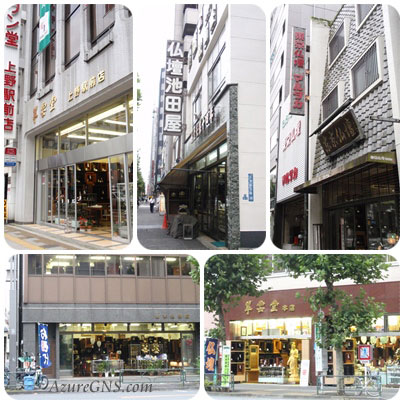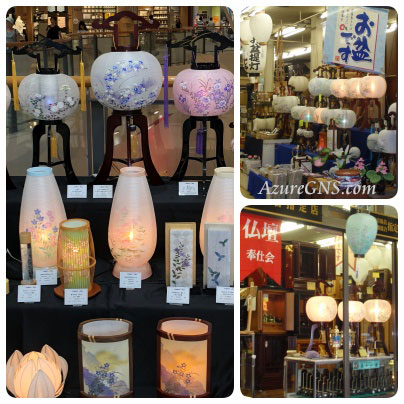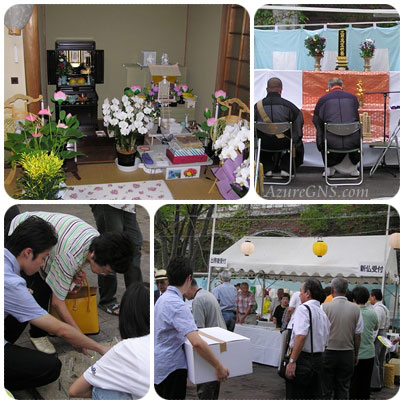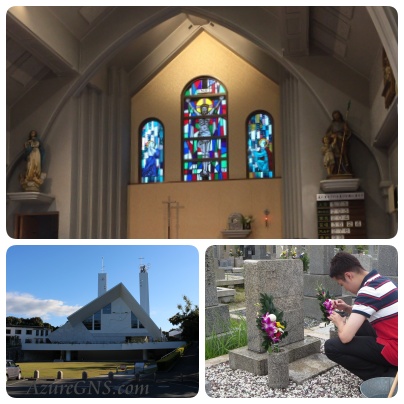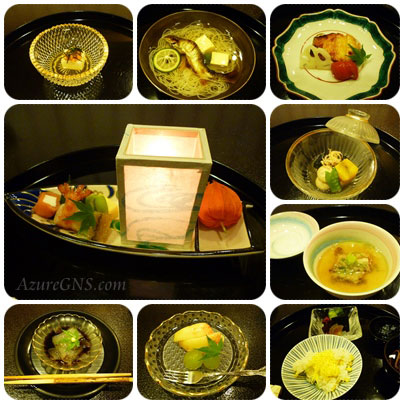Wagaya no O-bon;
Our Bon Festival Experience
お盆は年に一度、8月13日から15日、もしくは7月13日から15日の3日間、先祖の霊をお迎えして、ご供養する、本来は厳粛な仏教、もしくは神道の儀式です。しかし、子供の頃の私にとってお盆は仏教的な儀式というより、もっと世俗的な楽しいお祭りといった感じでした。その頃、お盆が大好きで、夏休みの最も楽しい思い出の1つです。家族皆で両親の故郷に行き、お墓参りをしました。そして親戚が集まりお盆のご馳走を食べ、いとこ達と盆踊り、花火、夜店、ゲームなどを楽しみました。
O-bon is originally a solemn Buddhism or Shinto ritual that is celebrated annually to welcome the sprits of ancestors back home and honor them for three days from August 13th to the 15th or July 13th to the 15th. However, O-bon was more secular focusing much more on a happy festival than a religious ritual to me when I was a child. In those days, I really liked O-bon, and it is one of the most enjoyable summer vacation memories. I went to my parents’ hometown with my family and visited our ancestors’ graves. We reconnected with relatives and had a big O-bon dinner together. I enjoyed Bon-odori (Bon-dance), fireworks, night stalls and games with my cousins.
この写真は、2008年に夫と愛犬と一緒に行った金沢の盆踊りで撮ったものです。お盆の習慣は地方、仏教の宗派、世代などに広く異なります。同様に盆踊りにも、それぞれの固有の文化や歴史的に背景によって、その土地ならではの踊り方、盆唄、衣装があります。しかし、基本的に共通の特徴があり、覚えやすい振り付けで、リズミカルで活気のある歌に合わせて踊ります。ほとんどの踊り手は浴衣を着て、調和のとれた同じ動きをします。現代では、宗教的なものと言うより、単なる楽しむ傾向です。
I took these photos when my husband and I went to see Bon-odori or Bon dance with our beloved dogs in Kanazawa City. The customs of O-bon vary widely depending on regions, religions and generations. Likewise, Bon-odori, which is performed for consoling ancestors’ sprits, has an infinite variety of methods, songs and costumes depending on the unique culture and historical events from each region. Still all Bon-odori has basically similar distinctions: it is a dance performance with easy to learn movement to rhythmical and lively songs, dancers usually perform the same dance sequence in unison and most dancers wear yukata (casual cotton kimono for summer). These days, Bon-odori is more inclined toward entertainment rather than a ritual.
毎年、自宅近くの小学校で開催される盆踊りに、何度か愛犬のふーちゃん(女の子)、おーちゃん(男の子)を連れて行きました。会場で浴衣を着た可愛い小学生の女の子達に我が家の犬は撫でてもらい嬉しそうでした。我家の愛犬達も浴衣を何枚か持っていて、夏祭りの時に着ることがあります。残念ながら、最近は犬を連れての入場は禁止になってしまいました。
Several times we took our beloved dogs Fuchan (female) and Ohchan (male) to the Bon-odori festival held annually at an elementary school nearby. Ohchan was happy to be petted by cute little girls in yukata. Our dogs also have some types of yukata and they sometimes wear them for summer festivals. I am sorry that dogs are not allowed at the elementary school these days.
徳島県の阿波踊りは岐阜県郡上市の郡上(ぐじょう)おどり、秋田県羽後町(うごまち)の西馬音内(にしもない)の盆踊と共に日本三大盆踊りと称されます。阿波踊りは日本各地に伝承され、特に東京では多くの人が踊ります。杉並区の高円寺や豊島区の大塚の阿波踊りが有名です。私達は大塚の阿波踊りを見物しました。暗くなると、見慣れた交通量の多い通りが盆踊りのステージに変わりました。数百人の踊り手が鐘や太鼓のリズムに乗って舞い踊っていました。
Awa-odori, or Awa dance in Tokushima Prefecture is one of the three major long-established Bon dances along with Gujo-odori in Gujo City, Gifu Prefecture and Nishimonai-no-Bon-odori in Ugo Town, Akita Prefecture. Awa-odori was handed down to many areas in Japan, especially to Tokyo such as in Koenji, Suginami Ward and in Otsuka, Toshima Ward. When it got dark, the familiar busy street became a Bon-odori stage. Hundreds of dancers were breaking into a rhythm to the sound of gongs and drums.
東京の我が家の近くの小石川傳通院でも毎年、お盆の法要が行われています。このお寺は東京都台東区上野の寛永寺、港区芝公園の増上寺とともに、徳川将軍家の菩提寺として有名です。1602年(慶長7年)に京都伏見城で亡くなった徳川家康の生母の於大の方が亡くなりました。於大の方(おだいのかた)を埋葬するため、家康は1415年(応永22年)に創建された寿経寺を現在の地に移しました。お寺の名前は於大の方の法名にちなんで傳通院と呼ばれるようになりました。境内には徳川家ゆかりの人々だけでなく、数々の著名人の墓地があります。
A Buddhist memorial service of O-bon is annually held at the Denzu-in Temple in Koishikawa near my home in Tokyo. This is famous as the temple of the Tokugawa Shogunate family along with the Kanei-ji Temple in Ueno, Taito Ward, Tokyo and the Zojo-ji Temple in Shiba Park, Minato Ward. In 1602 (Keicho 7th yr), Odai-no-kata, the real mother of Tokugawa Ieyasu (the first shogun of the Tokugawa Shogunate), passed away in Fushimi Castle in Kyoto. Ieyasu relocated the Jukyo-ji Temple established in 1415 (Ouei 22nd yr) to where the Denzu-in Temple stands now. The temple came to be called the Denzu-in Temple after Odai-no-kata’s Buddhist name. Not only graves of the Tokugawa family but also those of other famous people are in the graveyard of this temple.
2009年(平成21年)東京都豊島区巣鴨駅前の盆踊り大会に、息子も愛犬も浴衣を着て一緒に行きました。私は浴衣姿の愛犬はとても可愛いと思いましたが、残念ながら少しだけしか注目されませんでした。巣鴨は「おばあちゃんの原宿」として有名ですが、その日は意外に多くの若い人達が盆踊りに参加していました。盆踊りを見た後、巣鴨地蔵通り商店街の中程にある、とげぬき地蔵尊で有名な巣鴨の高岩寺まで行きお参りをしました。
In 2009, we went to Bon-odori in front of Sugamo Station in Toshima Ward, Tokyo with my son and dogs that wore yukata. Unfortunately, they only got a little attention of people though I thought my dogs in yukata were very cute. Sugamo is famous as “Grandmas’ Harajuku” (Harajuku is a very popular area among young girls.); however, to my surprise, many young people also took part in Bon-odori on the day. After seeing Bon-odori, we visited the Kogan-ji Temple, which is famous for Togenuki-jizo-son, in the middle of Sugamo Jizo-dori Shopping Street.
亡くなった方々の鎮魂のために、お盆の時期には日本中で多くの花火大会が開催されます。忘れられないほど美しい花火が夏の空を彩ります。また花火には迎え火や送り火の意味合いもあります。迎え火とは、8月13日(地方によっては7月13日)の夜に霊が迷わずに家に戻れるように、家の前で火を焚くことです。乾燥させた麻の茎を積み重ね燃やしたり、数本の麦藁を燃やしたりする方法が一般的でしたが、最近では火災になることを避けて、盆提灯で代用することもあります。送り火とは、16日にお盆に帰っていた霊を再びあの世に送り出すために焚かれます。
A lot of fireworks displays are held throughout Japan in and around the O-bon season to commemorate the souls of the dead. The hauntingly beautiful fireworks light up the summer night sky. Fireworks in the O-bon season sometimes play roles of Mukae-bi (welcome fires) and Okuri-bi (send-off fires) for spirits. Mukae-bi is fire which is made on a pile of dried stalks of lax or some pieces of straw at the outside door or the gate on the evening of the August 13th (or July 13th in some regions) so that the ancestors’ spirits easily find their way home. Lanterns are sometimes hung at outside doors instead of fire for fire prevention. Okuri-bi is lit in the evening of the 16th to send the sprits back to their world. Each region has its own unique style of both Mukae-bi and Okuri-bi.
五山の送り火は、京都のお盆で最も素晴らしい光景のひとつです。2010年(平成22年)8月16日に息子が京都へ行き、伏見稲荷と東寺へ行き、夜は五山の送り火を見ました。多くの人が集まり着火の時間を今か今かと待っていました。見物客の将棋倒しなどの事故が起こらないように、警察官が警察車両の上の指示台に乗って警戒していました。息子のいる所からは大文字と妙法だけが見えました。京都五山の送り火の起源は諸説ありますが、詳しい記録は江戸時代以降のものしか残っていません。東山如意ヶ嶽の大文字、松ヶ崎西山(万灯籠山)と東山(大黒天山)の妙法、西賀茂船山の船形、金閣寺大北山(大文字山)の左大文字、嵯峨曼荼羅山の鳥居形があります。午後8時にまず大文字、そして5分おきに残り4つが次々と点火されます。
Gozan-no-okuribi (the Send-off Fires from Five Mountains) is one of the greatest spectacles of the O-bon season in Kyoto. On August 16th in 2010 (Heisei 22nd yr), my son went to Kyoto, visited Fushimi Shrine and the To-ji Temple, and saw Gozan-no-okuribi. Thousands of people gathered and were excitedly waiting for the lighting time. Police officers standing on observation platforms on top of police cars were watching the spectators and directing them in case someone fell in the crush. My son could see only Daimon-ji and Myoho from where he was. There are several theories about the origin of Gozan-no-okuribi in Kyoto, and there are no detailed records before the Edo Period (1603-1868). Daimon-ji of Mt. Higashi Nyoigatake, Myoho of Mt. Matsugasaki Nishi (Mt. Mantoryu) and Mt. Higashi (Mt. Daikokuten), Funa-gata of Mt. Nishi-kamo-Funa, Hidari-daimon-ji of Mt. Kinkakuji Oh-kita and Torii-gata of Mt. Saga-Mandara. At 8:00pm, Daimon-ji is lit first, and the rest of the 4 are lit in order at 5-minute intervals.
送り火のひとつの形として、灯籠流し(とうろうながし)または精霊流し(しょうろうながしが全国の海や川で行われています。2009年(平成21年)7月に上野の不忍池の灯篭流しに出掛けました。少し行くのが遅かったので、残念ながら多くの灯篭の火は消えてしまっていました。2年後の2011年(平成23年)7月17日に再び不忍池へ行きました。他の日本の伝統的な祭り同様、綿飴、たこ焼、焼きそば、金魚すくい、ヨーヨー釣りなどの屋台が並んでいました。弁天堂の前では数名の僧侶により法要が行われていました。この年は明るいうちに不忍池に到着したので、灯籠流しの申し込みに間に合うことができました。同年の3月に起きた東日本大震災の犠牲者の慰霊と復興の願いを込めて、灯籠流しをお寺にお願いしました。池のほとりの松明に火がともり、ボートに乗った僧侶が灯籠を池に浮かべました。水面に映る提灯やネオンの明りがとてもきれいでした。
Toro-nagashi, also known as Shoro-nagashi is another type of Okuri-bi which is performed at the sea or the river. In July 2009, I went to Shinobazu-no-ike (Shinobazu Pond) to take part in Toro-nagashi. I reached the pond a little late, so most of the lanterns had already faded. On July 17th in 2011 (Heisei 23rd), two years later, I went to Shinobazu-no-Ike again. Just like other traditional Japanese festivals, the streets were lined with stalls selling takoyaki, yakisoba, cotton candy, kingyo-sukui and yo-yo-tsuri. A Buddhist memorial service was being held in front of the Benten-do Temple by some Buddhist priests. As I reached Shinobazu Pond before the dark this time, I was able to apply for Toro-nagashi. I asked the temple to set afloat my Toro for the victims and the restoration of the Great East Japan Earthquake which occurred in March of the same year. After torches by the pond were lit, two priests on the boat floated one Toro after another. The light of lanterns and neon signs were reflecting beautifully on the surface of the water.
2014年(平成26年)8月16日に、息子が灯籠流しのために友人と東京都台東区の浅草へ出かけました。第二次世界大戦が終わった翌年の1946年(昭和21年)に行われた復興祭のときに、隅田川に灯籠が流されたことが始まりと言われています。1966年(昭和41年)に、隅田川に高潮防止の防波堤が整備されたため中止になりました。しかし2005年(平成17年)に隅田川親水テラスが繋がり、スロープも整備されたため灯籠流しは再開されました。息子や友人はスカイツリーを向こうに眺め、祈りを込めて一つずつ灯籠を流しました。浅草寺はいつも以上に混雑して、近くでは盆踊りも開催されていました。
On August 16th, 2014 (Heisei 26th yr), my son went to Asakusa, Taito Ward, Tokyo with his friends so that they could join Toro-nagashi. This Toro-nagashi dates back to Fukko-sai (the Rehabilitation Festival) in 1946 (Showa 21st), the next year after the end of World War ll, and in the festival people floated Toro in the Sumida River. In 1966 (Showa 41st yr), construction of the breakwater along the Sumida River for storm surge prevented Toro-nagashi from taking place. However, in 2005 (Heisei 17th yr), Toro-nagashi was resumed because the Sumida-gawa Shinsui Terrace (the Sumida River Riverside Esplanade) and the slope were completed. My son and his friends prayed for the repose of souls and floated Toro one by one, with the Tokyo Skytree in the background. Sensoji Temple was more crowded than usual, and Bon-odori was also taking place.
これらはお盆休み中の典型的な光景です。お盆休みには駅や空港が帰省や旅行をする大勢の人で大混雑します。切符を買う、改札を通る、お土産を買う、トイレに行く、何をするにも忍耐強く列に並ばなければいけません。この混雑を避けて、お盆は家でのんびりする人も多くいます。
These were typical scenes at Tokyo Station during the O-bon holiday. During the O-bon holiday, stations and airports are overcrowded with multitudes of passengers going home or taking a trip. People must be very patient whenever they buy tickets, go through ticket gates, buy gifts or use lavatories. Many people relax at home to stay away from congestion.
お盆期間中の高速道路の混雑はかなり深刻で、時には渋滞が数十キロ続くことがあります。毎年、その時期の高速道路渋滞予測が事前に発表されます。2009年(平成21年)政府は景気対策の一つとして、高速道路でのETC(ノンストップ自動料金収受システム)使用者への割引を始めました。週末やゴールデンウィークやお盆などの特別の休暇には距離が無制限で、高速料金がたったの1000円になりました。その結果、ETCの普及には大きな成果を上げたようですが、予想通り高速道路が例年以上に渋滞しました。
During the O-bon holiday, traffic on highways is terribly congested and is sometimes backed up for tens of kilometers. Every year, the prediction of congestion during O-bon is announced in advance. In 2009, the government introduced some new economic stimulus measures, and the discount system for users of ETC (Electric Toll Collection System) on freeways was among them. Using IC cards for ETC, we can drive on a highway as long as we like for only 1000 yen maximum on weekends and special holidays like Golden Week and O-bon. Eventually, the traffic jams on freeways in O-bon were worse than ever, as expected though this measure was reported to produce great results in the spreading of ETC.
浅草仏壇通りには約50件の仏具や神具の店が軒を連ねます。その歴史は古く、江戸時代(1603-1867)初期にさかのぼります。1657年(明暦3年)の大火災後、江戸幕府は大規模な都市再開発を行い、寺社をこの辺りに集めました。その結果、次第に仏具や神具を扱う店も集まってきました。
There are about 50 shops of Buddhist family altars, Shinto household altars, and their accessories on either side of Asakusa Butsudan Dori (Asakusa Family Buddhist Altar Street). The origin of the street dates back to the beginning of the Edo period (1603-1867). After a big fire in 1657 (Meireki 3rd yr), the Edo shogunate carried out a large-scale urban renewal and gathered temples and shrines around there. Therefore, shops dealing with Buddhism and Shintoism gradually gathered in this area.
現在ではお盆が近付くと仏壇・仏具店ではセールが始まります。店頭には日本の伝統的な盆提灯が並びます。故人が迷わずに帰って来られるように灯されます。お盆に不可欠な数珠、線香、蝋燭などが売られています。火事防止のために、電気の線香や蝋燭もあります。故人が好きだったビール、お酒、和菓子などの形をした新しいタイプの蝋燭もあります。暑い時期はお花がすぐにだめになるので、仏花の造花も売られています。
Nowadays they have sales as O-bon is drawing near at the shops selling Butsudan (Buddhist family altars) and Buddhist articles. Bon-chochin, Japanese traditional paper-wood lanterns for the Bon festival, are in the stores. They are lit to help the souls of ancestors and deceased family members not to lose their way. The shops sell essential things for O-bon: juzu (Buddhist rosaries), incense sticks and candles. They also sell electric incense sticks and candles for fire prevention, and new types of candles in the forms of what the deceased liked such as beer, sake and sweets. As flowers for offering to Butsudan tend to wither quickly during summer, artificial flowers can be substituted for fresh flowers.
父の初盆の写真です。父の先祖代々の大きな仏壇は父の実家にあり、父は次男なので家族の仏壇を新しく購入しなければいけませんでした。両親には息子がいなく、娘が二人とも他家に嫁いでいる為、家を継ぐ者がいません。それゆえ、父と将来母の二人のみが入るので、小さな仏壇にしました。最近は核家族、跡取り不足、住宅事情などの理由で、このようなコンパクトな仏壇が増えています。8月15日にお盆のお供えを神戸市役所横の東山遊園地へ家族と一緒に持って行きました。ボランティアのお坊様達が改めて父の為にお経をあげてご供養して下さいました。その後、お供えを処分して頂きました。昔は川や海に流していましたが、環境問題を考慮して、他の多くの地域同様に今は神戸市もこのような形になったようです。
These are photos of my father’s Nii-bon (the first O-bon). A big Butsudan (a family Buddhist altar) of my father’s ancestors is in his family’s house, so we had to buy a new one because he was the second son. My parents don’t have any sons, only two daughters who are already married; in other words, they don’t have any children to succeed them; therefore, we bought a small Butsudan for two, my father and in the future my mother. Lately such a compact Butsudan is more and more popular due to a small family, lack of a successor and housing situations. I brought offerings for the Bon festival to Higashiyama Yuenchi Park next to the Kobe City Hall with my family on August 15th. The volunteers of the Buddhist priests chanted the sutra again for my father, and they disposed of offerings for us. In the past, people used to float offerings down the river or in the sea; however, now citizens in Kobe like other many cities have stopped this custom in consideration of environmental problems.
我々はクリスチャンですが、毎年お盆には両家のお墓へ行き、墓石をきれいに掃除して、雑草を抜きます。そしてお線香とろうそくに火をつけ、故人が好きだったものをお供えします。多くの日本のキリスト教の教会ではお盆の頃に御ミサが行われます。
We pay our respects at both the graves of my husband’s and my families during O-bon every year and clean the graves and weed around them even though we are Christians. We light incense sticks and candles and offer what deceased family members liked such as sweets and fruits. Many Christian churches hold a special mass during a O-bon holiday.
お盆に夫が胡瓜の馬と茄子の牛を作り仏壇にお供えしました。胡瓜は先祖が乗って急いで家に帰って来る馬、茄子は先祖が乗ってあの世にゆっくり帰る牛を表しています。鬼灯(ほおずき)は迎え火と送り火の提灯に見立ててお盆の間仏壇に飾られます。
My husband made a horse of a cucumber and a cow of an eggplant for O-bon and offered them to Butsudan. A cucumber symbolizes a horse on which one’s ancestors quickly come home, and an eggplant symbolizes a cow on which one’s ancestors slowly go back to the next world. Regarded as a lantern of Mukae-bi and Okuri-bi, Hozuki (a ground cherry) is offered to Butsudan during O-bon.
2013年(平成25年)から和食はユネスコの無形文化遺産に登録されています。それも納得するように素晴らしいお盆の会席料理です。精霊流しをかたどった木の器にお料理が盛られ、お盆につきものの鬼灯が添えられていました。鮎の塩焼きをはじめ、旬の食材を使った美しい料理が次々と出てきました。
In 2013 (Heisei 25th yr), Washoku (Japanese cuisine) was added to the list of Intangible Cultural Heritages by UNESCO. Seeing and eating these special dishes for O-bon, it is no wonder that Washoku is recognized worldwide. A wooden dish in the shape of a ship for Toro-nagashi was served with Hozuki (a ground cherry) which is indispensable for O-bon. Beautiful and delicious dishes with seasonal ingredients including a grilled ayu (a sweetfish) were served one after another.
(「お盆」に戻ります。)
(Back to “The Bon Festival”.)
Copyright (C) Azure Global Network Services. All Rights Reserved.

